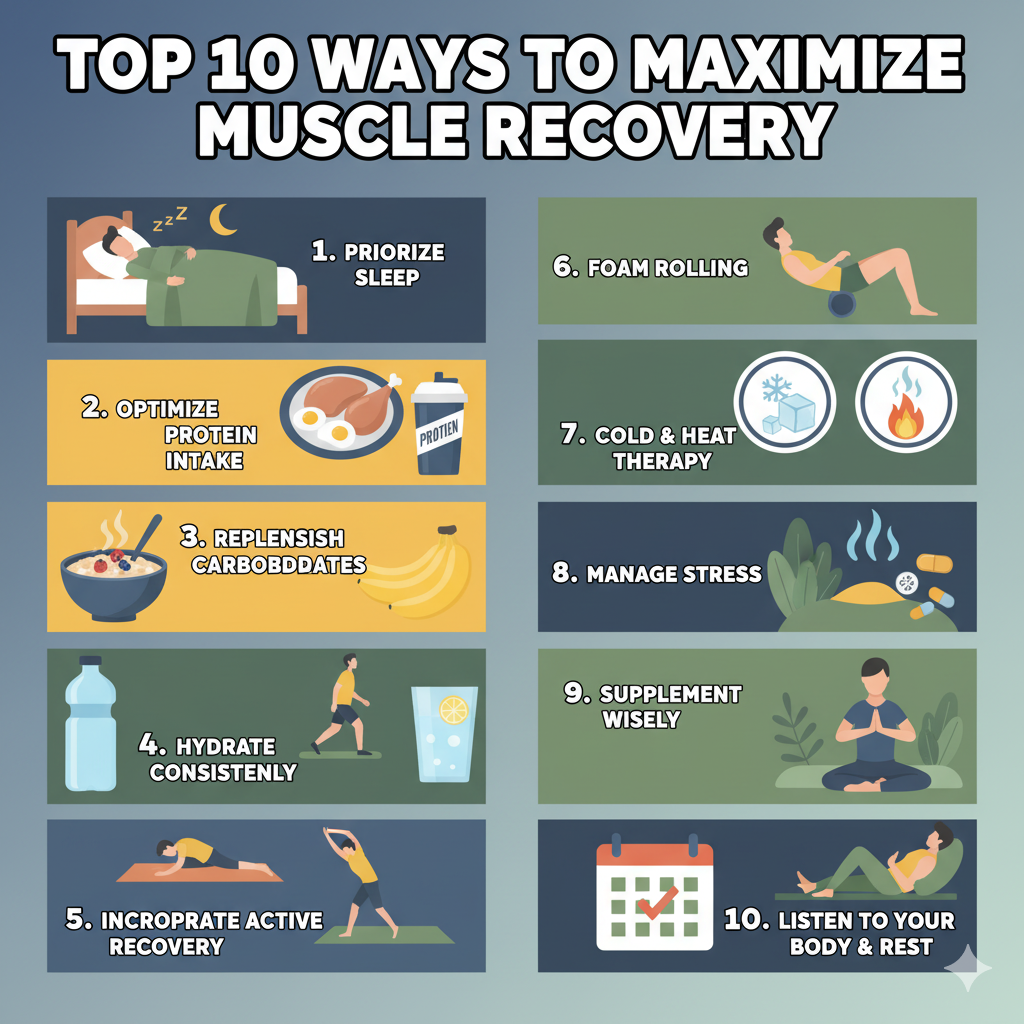
Top 10 Ways to Maximize Muscle Recovery
The Top 10 Ways to Maximize Muscle Recovery
Whether you're a seasoned athlete, a weekend warrior, or just starting your fitness journey, optimizing muscle recovery is crucial for progress, preventing injury, and feeling your best. When you push your muscles during exercise, you create micro-tears and deplete energy stores. Effective recovery strategies allow your body to repair, rebuild, and come back stronger. Here are the top 10 ways to maximize your muscle recovery:
1. Prioritize Adequate Sleep
This is arguably the most critical recovery tool. During deep sleep, your body releases growth hormone, which is essential for muscle repair and growth. Aim for 7-9 hours of quality sleep per night. Creating a consistent sleep schedule and a relaxing bedtime routine can significantly enhance recovery.
2. Optimize Protein Intake
Protein provides the amino acids necessary for muscle repair and synthesis. Consume 1.6g to 2.2g of protein per kilogram of body weight daily, spread throughout your meals. Focus on high-quality sources like lean meats, poultry, fish, eggs, dairy, and plant-based proteins such as legumes and tofu. Consuming protein shortly after a workout can kickstart the recovery process.
3. Replenish Carbohydrates
After intense exercise, your muscle glycogen stores are depleted. Carbohydrates are vital for replenishing these stores, providing energy for daily functions and subsequent workouts. Include complex carbohydrates like whole grains, fruits, and vegetables in your diet, especially in your post-workout meal.
4. Hydrate Consistently
Water plays a critical role in almost every bodily function, including nutrient transport, temperature regulation, and joint lubrication. Dehydration can impair performance and slow down recovery. Drink plenty of water throughout the day, increasing your intake around your workouts. Electrolyte-rich beverages can also be beneficial, especially after prolonged or intense exercise.
5. Incorporate Active Recovery
While rest is important, complete inactivity isn't always the best approach. Active recovery involves low-intensity exercise like light cardio (walking, cycling), stretching, or yoga on rest days. This helps increase blood flow to muscles, delivering nutrients and removing waste products, without causing further damage.
6. Utilize Foam Rolling and Self-Myofascial Release
Foam rolling can help release muscle tightness and knots, improve flexibility, and reduce soreness. By applying pressure to specific areas, you can increase blood flow and potentially break up adhesions in the fascia, promoting better muscle function and recovery.
7. Consider Cold and Heat Therapy
- Cold Therapy (Ice Baths, Cold Showers): Can help reduce inflammation and soreness immediately after intense exercise by constricting blood vessels.
- Heat Therapy (Warm Baths, Saunas): Can improve blood flow, relax muscles, and relieve stiffness, often beneficial for delayed onset muscle soreness (DOMS) a day or two after a workout.
- Alternating between cold and hot (contrast therapy) is also a popular method for stimulating blood flow and promoting recovery.
8. Manage Stress Levels
Chronic stress can elevate cortisol levels, a hormone that can break down muscle tissue and impede recovery. Incorporate stress-reduction techniques into your daily routine, such as meditation, deep breathing exercises, spending time in nature, or engaging in hobbies you enjoy.
9. Supplement Wisely (When Needed)
While a balanced diet should be your primary focus, certain supplements can support recovery:
- Creatine: Aids in energy production and can enhance muscle growth and strength.
- Branched-Chain Amino Acids (BCAAs) / Essential Amino Acids (EAAs): Can support muscle protein synthesis and reduce muscle breakdown.
- Omega-3 Fatty Acids: Have anti-inflammatory properties that can aid recovery.
- Magnesium: Involved in muscle function and relaxation; can help with muscle cramps and sleep.
Always consult with a healthcare professional before adding new supplements to your regimen.
10. Listen to Your Body and Plan Rest Days
Perhaps the simplest yet most overlooked recovery strategy. Your body provides signals when it needs rest. Pushing through severe fatigue or pain can lead to overtraining, injury, and burnout. Incorporate dedicated rest days into your training schedule and don't be afraid to take an extra rest day if your body demands it. Periodizing your training with lighter weeks can also be highly effective for long-term progress and recovery.
By incorporating these 10 strategies into your fitness routine, you can significantly enhance your muscle recovery, leading to better performance, fewer injuries, and a more sustainable fitness journey.
